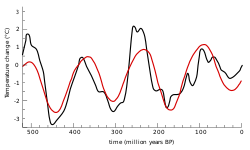宇宙気候学
 ウィキペディアから無料の百科事典
ウィキペディアから無料の百科事典

宇宙気候学(うちゅうきこうがく、Cosmoclimatology)とは、地球の気候変動に対する宇宙現象の影響を研究対象とした学問分野。用語は2007年にスベンスマルクによって考案された[2]。
宇宙線の影響[編集]
宇宙気候学における仮説の一つに、付加的な雲核の核形成(nucleation)による下部対流圏における雲量の変化に対する銀河宇宙線の影響がある。その考えは提案中のもので、まだ証明されていない、地球の気候変動に対する太陽変動の影響に関する仮説の一つである[3]。
雲に及ぼす銀河宇宙線の影響を実験的に調べるため、CERNでは2006年に陽子シンクロトロン(Proton Synchrotron)から発生させた荷電π中間子の加速器ビームを用いてチャンバー内における核形成の測定が予備段階の実験として行われている[4]。
一方、顕生代にわたる長期の気候変動におよぼす銀河宇宙線の影響を調べた研究によれば、地球は1.35億年の周期で銀河系のらせん状の腕(Spiral arm)を通過し、その銀河系の腕から多量の宇宙線を浴びたときに寒冷化傾向を示しており、過去5億年にわたって地球が浴びた宇宙線量の変調と気温変化の間に強い相関が見出されている[1][5][6]。これについて、宇宙線が大気の分子と衝突して生成された大気イオンがエアロゾルを形成し、そのエアロゾルが雲粒の凝結核となり、雲が増加することで地球の太陽光反射率(アルベド)が上昇して寒冷化するというモデルが提案されている[7]。
その他[編集]
銀河宇宙線だけでなく、軌道要因等を含む太陽活動の変動[8]、太陽紫外線の変調[9][10]、太陽フレア[11]、地球外揮発性物質[12]、流星煙粒子[13]、惑星間塵[14]、宇宙塵[15][16]など、様々な因子がそれぞれの時間スケールにおいて気候に摂動を与える可能性として提案されているが、いずれも定説として評価が定まっているわけではなく、特に惑星間塵等が気候に及ぼす寄与や影響に対する定量的評価やメカニズムに対して確立された段階に至っているとは言えない[note 1]。
ただし、星間ガスを介した気候への影響[17]を調べる過程で、銀河系の腕が気候に摂動を与える候補として提案されたこともあり[note 2]、2002年にNir Shavivの論文[18]によって銀河系の腕と太陽系の位置関係によって変調する銀河宇宙線と気候の長期的関連が一般に注目を浴びる[19][20]以前に、先行して、銀河系の腕が気候に影響を及ぼす可能性が探索されていた。
日本において宇宙気候学という用語が用いられた例として、1992年の科学雑誌に高エネルギー宇宙物理学者の桜井邦朋による記述がある[21]。その雑誌の中で桜井氏は宇宙気候学の重要性を、ケベック大停電などを引き起こした1989年3月の磁気嵐の原因である太陽フレア現象や、宇宙空間における人間活動のための宇宙天気予報、さらに小氷期と太陽活動との関連において位置づけている。
小氷期は太陽活動の低下したマウンダー極小期と時期が重なり、太陽などの天体活動と気候を関連付けた初期の研究対象の一つとなっている。マウンダー極小期は1975年に太陽物理学者のジャック・エディによって名づけられており、論文は1976年に発表され[22]、その後の宇宙気候学の嚆矢となった。
関連項目[編集]
出典[編集]
- ^ a b Nir J. Shaviv and Ján Veizer (2003). “Celestial driver of Phanerozoic climate?”. GSA Today 13 (7): 4–10. doi:10.1130/1052-5173(2003)013<0004:CDOPC>2.0.CO;2. see also online discussion
- ^ Henrik Svensmark (2007). “Cosmoclimatology: a new theory emerges”. Astronomy & Geophysics 48 (1): 1.18-1.24. doi:10.1111/j.1468-4004.2007.48118.x.
- ^ Kristjansson, J. E.; Kristiansen, J. (2000). “Is there a cosmic ray signal in recent variations in global cloudiness and cloud radiative forcing?”. Journal of Geophysical Research 105 (D9): 11851-11863. doi:10.1029/2000JD900029.
- ^ J. Duplissy et al. (2010). “Results from the CERN pilot CLOUD experiment”. Atmos. Chem. Phys. 10: 1635?1647. doi:10.5194/acp-10-1635-2010.
- ^ Nir J. Shaviv (2003). “The Spiral Structure of the Milky Way, Cosmic-Rays and Ice-Age Epochs on Earth”. New Astronomy 8: 39. doi:10.1016/S1384-1076(02)00193-8.
- ^ K. Scherer et al. (2006). “Interstellar-Terrestrial Relations: Variable Cosmic Environments, The Dynamic Heliosphere, and Their Imprints on Terrestrial Archives and Climate”. Space Science Reviews 127: 327-465. doi:10.1007/s11214-006-9126-6.
- ^ Nigel D. Marsh and Henrik Svensmark Low Cloud Properties Influenced by Cosmic Rays Physical Review Letters, Vol.85, Iss. 23, 5004 (2000年12月4日)
- ^ Julien Emile-Geay et al. (2007). “El Niño as a mediator of the solar influence on climate”. Paleoceanography 22: PA3210. doi:10.1029/2006PA001304.
- ^ Alexander Ruzmaikin et al. (2006). “Is solar variability reflected in the Nile River?”. Journal of Geophysical Research 111: D21114. doi:10.1029/2006JD007462.
- ^ J. Austin et al. (2008). “Coupled chemistry climate model simulations of the solar cycle in ozone and temperature”. Journal of Geophysical Research 113: D11306. doi:10.1029/2007JD009391.
- ^ Nicola Scafetta and Bruce J. West (2003). “Solar Flare Intermittency and the Earth’s Temperature Anomalies, The Dynamic Heliosphere, and Their Imprints on Terrestrial Archives and Climate”. Physical Review Letters 90 (24): 248701. doi:10.1103/PhysRevLett.90.248701.
- ^ David Deming (1999). “On the possible influence of extraterrestrial volatiles on Earth's climate and the origin of the oceans”. Palaeogeography, Palaeoclimatology, Palaeoecology 146 (1): 33-51. doi:10.1016/S0031-0182(98)00144-8.
- ^ Paolo Gabrielli et al. (2006). “A climatic control on the accretion of meteoric and super-chondritic iridium–platinum to the Antarctic ice cap”. Earth and Planetary Science Letters 250: 459-469. doi:10.1016/j.epsl.2006.08.015.
- ^ Gisela Winckler et al. (2004). “Does interplanetary dust control 100 kyr glacial cycles?”. Quaternary Science Reviews 23: 1873-1878. doi:10.1016/j.quascirev.2004.05.007.
- ^ V. I. Ermakov et al. (2009). “Influence of cosmic rays and cosmic dust on the atmosphere and Earth’s climate”. Bulletin of the Russian Academy of Sciences: Physics 73 (3): 416-418. doi:10.3103/S1062873809030411.
- ^ V. I. Ermakov et al. (2009). “The impact of cosmic dust on the Earth’s climate”. Moscow University Physics Bulletin 64 (2): 214-217. doi:10.3103/S0027134909020234.
- ^ R. D. Tarsia et al. (1988). “The interstellar medium and the glacial eras during the Pleistocene”. Earth, Moon, and Planets 41 (2): 173-190. doi:10.1007/BF00056402.
- ^ Nir J. Shaviv (2002). “Cosmic Ray Diffusion from the Galactic Spiral Arms, Iron Meteorites, and a Possible Climatic Connection”. Physical Review Letters 89 (5): 051102. doi:10.1103/PhysRevLett.89.051102.
- ^ Story #34 from 100 Top Science Stories of 2002 in Discover Magazine
- ^ David Whitehouse (2002年7月31日). “Galaxy 'may cause ice ages'”. BBC news. 2010年8月2日閲覧。
- ^ 桜井邦朋「宇宙気候学の試み」 、『数理科学』 サイエンス社 1992年10月号 No.352、p66-69
- ^ John A. Eddy (1976). “The Maunder Minimum”. Science 192 (4245): 1189-1202. doi:10.1126/science.192.4245.1189. オリジナルの2010年2月16日時点におけるアーカイブ。.
脚注[編集]
- ^ Kenneth A. Farley et al. (2006). “A late Miocene dust shower from the break-up of an asteroid in the main belt”. Nature 439: 295-297. doi:10.1038/nature04391. "Previous work has suggested a possible link between the IDP accretion rate and Earth's climate25. Correlations between extraterrestrial 3He in sediments and global climate in the Quaternary period may support this suggestion9 but also may be an artefact of climate-induced changes in sedimentation26....Although the relative timing of these events is suggestive, we caution that a compelling link between the events cannot be established until a plausible mechanism is found by which IDPs can change climate."
- ^ 桜井邦朋『太陽放射と地球温暖化』海鳴社、1990年、104-105頁。ISBN 4-87525-058-4。"この天の川銀河を、太陽は三億年ほどかけて一周するので、その間に、何回か腕の(アーム)の中へ入ったり、出たりすることになる。…(中略)…侵入してきた星間ガスによって、太陽光がさえぎられれば、地球からみた太陽の明るさがみかけ上減ると考えられるから、このような事態が起こったときには、地球は氷河時代を経験することになるであろう。氷河時代の成因として、このような仮説が、実際にかつて提案されたことがあるのである。"。
関連書籍[編集]
- H. スベンスマルク、N. コールダー 著、青山洋 訳『“不機嫌な”太陽―気候変動のもうひとつのシナリオ』桜井邦朋監修、恒星社厚生閣、2010年3月。ISBN 4-7699-1213-7、ISBN-13:978-4-7699-1213-2。2022年4月18日閲覧。